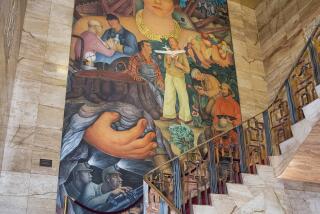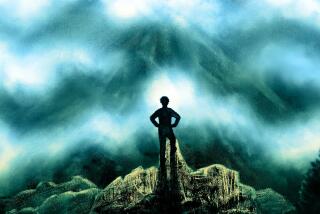For Intrepid Explorers Past and Present, a Woman’s Place Is Far From Home
- Share via
“I am always frightened in the jungle--always prepared for a violent death. But I love it!” So said Delia J. Akeley, the first Western woman to cross the African continent, at the helm of an expedition mounted in 1924 by the Brooklyn Museum of Arts and Sciences. Along the way from the Indian Ocean to the Atlantic, she lost 30 pounds, shot a waterbuck and a small African antelope called a dik-dik to take back to the museum (preserved by taxidermy) and made friends with the Congo Pygmies of the Ituri Forest, bringing back data on their customs, diet and diminutive stature.
Her story and those of four other pioneering women explorers are told in “Women of the Four Winds” by Elizabeth Fagg Olds (Houghton Mifflin Co., $13.95), a book published in 1985 that I cuddled up with one rainy weekend not long ago. And it was almost as good as taking a trip because part of what first inspired me to travel is my romance with the idea of exploration.
One of my all-time favorite books is Alan Moorehead’s “The White Nile” (Penguin Books, $21.95), chronicling the mid-19th century search for the source of the River Nile, including the exploits of Samuel Baker and his wife, Florence. At one point during the Bakers’ malaria-ridden wanderings in central Africa, the King of Bunyoro tried to make Samuel trade Florence for a young Bunyoro virgin, which I found riveting.
But better still to learn, on the couch that wet weekend, that the “women of the four winds” were a far cry from barter goods--in fact, they were intrepid expeditioners, who all died at an advanced age, at home in bed.
More important still, most were field scientists embarked on missions devoted in part to learning more about the world: the indomitable mountaineer Annie Smith Peck, for example. At the age of 58 and after five aborted attempts, she reached the summit of 22,198-foot Mt. Huascaran in Peru, though the Swiss guide who accompanied her lost the equipment she’d brought along to measure the mountain’s height. For this reason, she persisted in thinking Huascaran the greatest mountain in the Western Hemisphere, when actually that record belongs to Chile’s Aconcagua at 23,034 feet. Still, you have to like Annie, who considered chocolate “absolutely essential” to mountaineering and who once said, “One of the chief difficulties in a woman’s undertaking an expedition of this nature is that every man believes he knows better what should be done than she.”
Most of these women were members of the Society of Women Geographers, founded in New York in 1925 to support the efforts of women explorers and field researchers. At the time, a similar group for men, the venerable Explorers Club, was already in existence, though it didn’t start accepting women until 1981. A bit of doggerel published in the British magazine Punch in 1893 perhaps explains why it took the women so long to organize:
A Lady an explorer? a traveller in skirts?
The notion’s just a trifle too seraphic:
Let them stay and mind the babies, or hem our ragged shirts;
But they mustn’t, can’t, and shan’t be geographic.
Nevertheless, the Society of Women Geographers now boasts 600 members worldwide, including oceanographer Sylvia Earle, astronaut Kathryn Sullivan and alpinist Arlene Blum. It also awards fellowships to aspiring young women studying for advanced degrees in geography and related sciences, and has chapters in Washington, D.C., New York, Chicago, San Francisco, Florida and Los Angeles.
With so much of our world charted and known, the organization has focused increasingly on research. For instance, the chair of the L.A. chapter, Jill Cherneff, a researcher at UCLA’s Center for the Study of Women, did fieldwork among tribal groups in the Philippines and now is writing a biography of the anthropologist Hortense Powdermaker. Another L.A. chapter member, Ann Muscat, made two trips to the Antarctic to study marine organisms and now serves as deputy director for exhibitions and education at the new California Science Center in Exposition Park.
And UCLA-based Patricia Anawalt, PhD, who received the organization’s prestigious Outstanding Achievement Award in 1993, invented a whole new field of research, studying textiles made by indigenous Indian groups in eastern Mexico in order to broaden our understanding of the effects of the Spanish Conquest. I asked Anawalt if she considered herself an explorer. “Yes,” she said. “I’ve explored a new topic.” Beyond that, to collect samples and meet Indian weavers she had to travel to remote parts of Mexico, driving on rutted tracks and fording rivers.
Muscat thinks that introducing girls to science is of paramount importance in breaking down barriers.
Sometimes when she talks about her exploits in the Antarctic with groups of schoolgirls at the Science Center, Muscat gets questions like, “Does your husband let you do this?” According to Muscat, youngsters like these need to be exposed to female role models who can introduce them to the excitement of scientific study and let them know that they, too, can be researchers and explorers. After all, they don’t need anybody’s permission to forge on in the footsteps of Sacajawea, Amelia Earhart, Margaret Mead, Jane Goodall, Delia Akeley and Sally Ride.
The Society of Women Geographers, 415 E. Capitol St., S.E., Washington, DC 20003, telephone (202) 546-9228; The Explorers Club, 46 E. 70th St., New York, NY 10021, tel. (212) 628-8383.
More to Read
Sign up for The Wild
We’ll help you find the best places to hike, bike and run, as well as the perfect silent spots for meditation and yoga.
You may occasionally receive promotional content from the Los Angeles Times.






